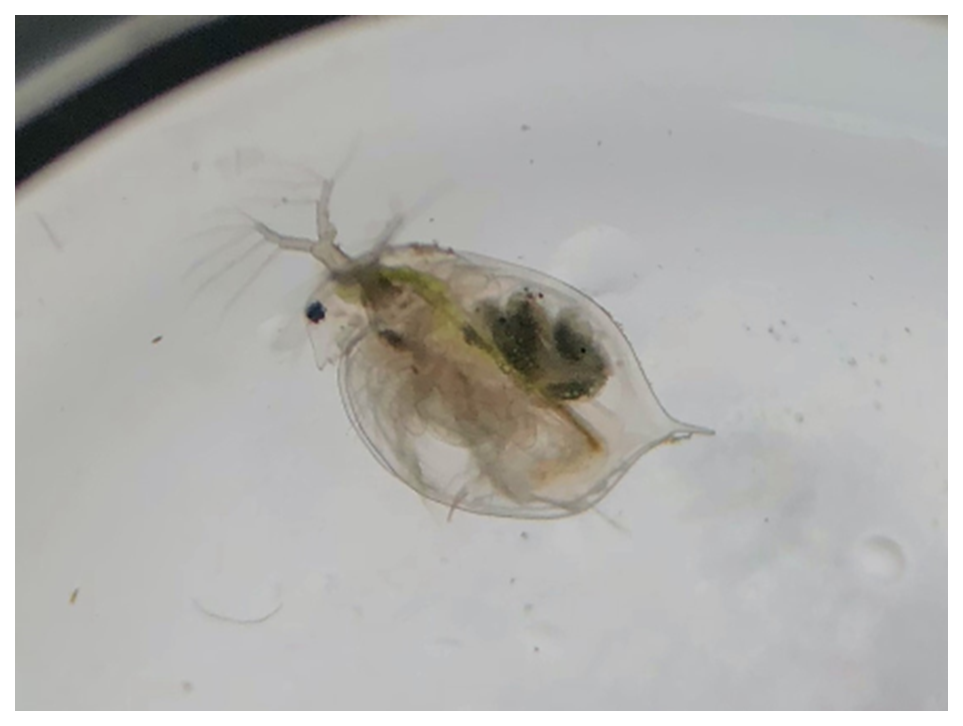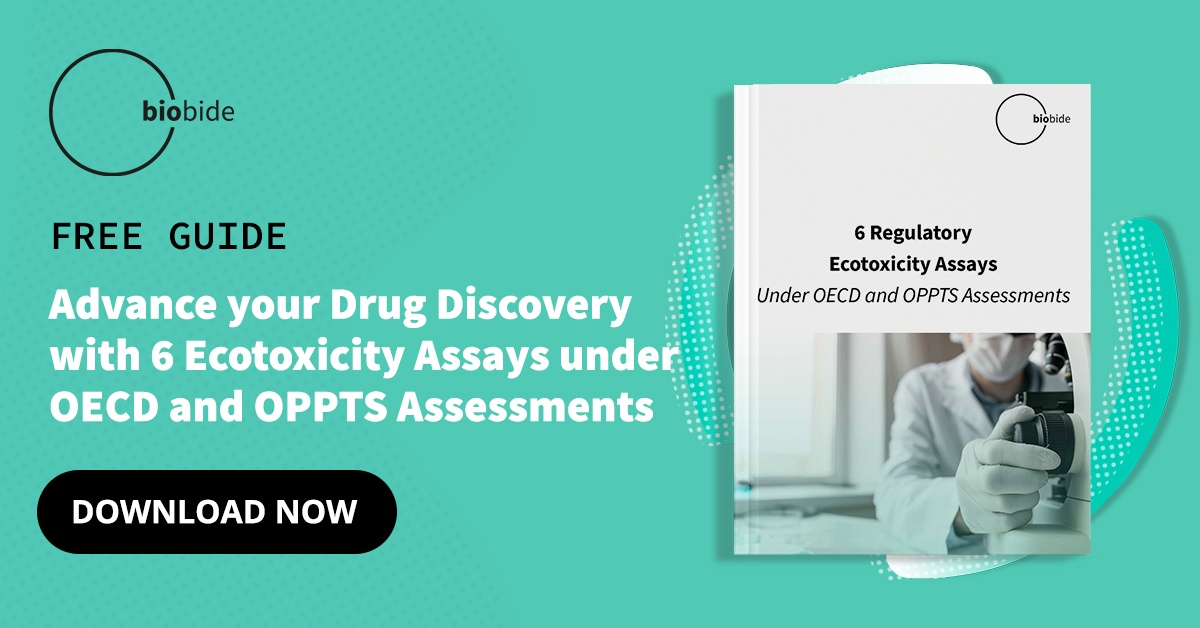Daphnia genus species, such as Daphnia magna, commonly known as daphnid or water flea, are plankton-feeding crustaceans that can be found in most bodies of water. These animals have very protuberant external features that make them unique like their single big eye and the duple pairs of branched antennae. The crustacean uses the antennae for locomotion and the thorax and the belly are covered and protected by an uncalcified translucent shell made out of chitin, which is a polysaccharide. Their characteristics flatten leaf-looking legs, they can have up to ten pairs, and help this individual to produce a water current that assists and directs food sources to the mouth.
These organisms are widely used in ecology to assess the toxicity of potential water pollutants due to the many benefits they present, being a cost-effective and ethically kind option, and the important role they present in water ecosystems. All the benefits daphnids present make them widely used in the ecotoxicity field and being accepted by regulatory agencies with several standardized tests as the ones set up by the OECD.
Relevance of Daphnids in water ecosystems
Daphnids present a pivotal role within aquatic ecosystems, exerting multifaceted influences on various ecological processes. Their significance stems from their position as keystone species, orchestrating intricate interactions and maintaining the delicate balance of aquatic environments.
Daphnids are voracious filter feeders, primarily consuming phytoplankton and suspended organic matter from the water column. By regulating phytoplankton populations, they prevent excessive algal blooms, maintaining water clarity and nutrient cycling. In turn, this mitigates nutrient imbalances and oxygen depletion, crucial for sustaining aquatic life.
Daphnids are a staple food source for various aquatic predators, including small fish, insects, and juvenile amphibians. This makes them a critical energy conduit between primary and secondary consumers, supporting the broader aquatic food chain.
The presence and abundance of daphnids can also serve as indicators of ecosystem health and biodiversity. Daphnid populations respond sensitively to changes in water quality, temperature, and nutrient availability, making them useful bioindicators for assessing environmental conditions.
Beyond their ecological roles, daphnids are useful in scientific research, particularly in ecotoxicology studies. Their sensitivity to contaminants makes them effective tools for gauging environmental pollution and the potential impacts of toxic substances.
Use of daphnids in toxicity assays for water pollutants
Daphnids present many benefits as model organisms for ecotoxicity studies, among these benefits, stand out the following:
- Sensitivity to Environmental Changes: Daphnids are highly sensitive to changes in their environment, making them excellent indicators of even subtle ecological disruptions. This sensitivity allows researchers to detect the effects of low-level pollutants that might go unnoticed by other organisms.
- Small size: These organisms are very small animals with a maximum size of 5-6 mm, making them very easy to store and grow in high amounts with minimum costs.
- Short Life Cycle: They present a relatively short life cycle, with some species completing it within weeks.
- High Reproduction Rate: They have a rapid reproduction that can be asexual, resulting in the quick generation of offspring. This not only allows a rapid testing capacity but also advantages for reproductive studies and multigenerational impacts.
- Transparency: They have transparent exoskeletons, which allows for easy observation of internal organs and physiological processes. This transparency is particularly useful for assessing heart rate, circulation, and other physiological parameters without the need for invasive procedures.
- Ease of Handling and Maintenance: Daphnids are relatively easy to handle and maintain in laboratory settings. They do not require sophisticated equipment or extensive care, which lowers the costs associated with toxicity testing.
- Ecosystem Relevance: these organisms are crucial components of aquatic ecosystems and play essential roles in nutrient cycling and food webs.
All these benefits make these organisms an attractive option for ecotoxicity testing and various types of assays have been set up:
- Acute Toxicity Test: in this assay, short exposure to high concentrations of a chemical substance is performed and the endpoint is the immobilization of the organism, based on its intrinsic behavior of constant movement.
- Chronic Toxicity Test: in this test, daphnids are exposed to a lower concentration of the substance during a longer period of time, compared with the acute test. In this case, different endpoints can be analyzed including growth, reproduction, or other physiological parameters such as behavior, endocrine disruption, or genetic damage.
- Heart Rate Monitoring: as mentioned, daphnids have a transparent exoskeleton, allowing researchers to observe their heartbeat under a microscope. Heart rate monitoring can be used as a sensitive indicator of stress caused by toxic substances or to assess cardiotoxicity.
The results obtained from these assays can provide valuable information for risk assessment and regulatory decision-making regarding chemical substances that can be pollutants in water environments. Another vast benefit when using daphnids is that this organism complies with the 3Rs Principles (Replacement, Reduction, and Refinement) since they are invertebrates, which are on a lower evolutive scale compared with vertebrates and, therefore, they are not under animal care policies as they present less ethical concerns compared with other animals. Thus, the use of daphnids reduces the need for more complex organisms in preliminary toxicity testing.
Biobide, as a prominent CRO (Contract Research Organization) in the ecotoxicology area, offers the Daphnia magna Acute Immobilisation Assay following the OECD 202 guideline. This assay is used to assess the effects of potential pollutants on aquatic organisms using daphnids. The purpose of this assessment is to determine if the concentration of the test compounds that cause immobilization to 50% of the studied daphnids median effective concentration (EC50) in the determined exposure time which usually is 24 to 48 hours. The word immobilization in this case refers to when the water fleas no longer swim or crawl in an active manner, this indicates that the test compound causes adverse effects in the behavior or has implications in the physiological functions.
Conclusions
Daphnids represent important testing organisms for assessing the toxicity of potential water pollutants due to their prominent role in the maintenance of water ecosystem homeostasis and the many benefits as model organisms present.
The use of this organism as a model organism results in its acceptance by regulatory bodies and produces the standardization of some of the tests commonly used in ecotoxicity analysis.
The relevance of toxicity assessment of the potential water pollutants is of special relevance due to the critical role water systems have in the maintenance of ecosystems. Thus, in the last decades, there have been a growing consciousness and knowledge about the importance of preserving ecosystems' balance and limiting their destruction to prevent the effects of climate change, species disappearance, and contamination of water supplies.
Therefore, a proper assessment of the toxic effects of chemical the many chemical compounds used in industry and daily consumption is a priority, and many regulatory and testing efforts are being made. In this context, the use of daphnids as model organisms for ecotoxicity testing is of great relevance and they are extensively used by agencies, governments, and companies.
In this sense, daphnid is a relevant, appropriate, and cost-effective model organism for ecotoxicity studies. Biobide as a CRO focused on the toxicity assessment of chemical compounds and pharmaceutical products offer different ecotoxicity assays on various model organisms including daphnids, algae, and zebrafish. The aim of the company is to push forward the safeguarding of water ecosystems which is crucial for limiting the harmful effects of human activity and protecting society's well-being.
Sources
- Introduction to Daphnia Biology - Ecology, Epidemiology, and Evolution of Parasitism in Daphnia - NCBI Bookshelf (nih.gov)
- The water flea Daphnia magna (Crustacea, Cladocera) as a test species for screening and evaluation of chemicals with endocrine disrupting effects on crustaceans | SpringerLink
- Test No. 202: Daphnia sp. Acute Immobilisation Test | READ online (oecd-ilibrary.org)
- The water flea Daphnia magna (Crustacea, Cladocera) as a test species for screening and evaluation of chemicals with endocrine disrupting effects on crustaceans | SpringerLink (unav.es)






